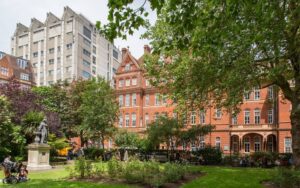
Lewy Body UK 2023 was hosted by University College London (UCL) at 33 Queen Square on 30th June 2023. This third instalment, organised by Professor John-Paul Taylor (Newcastle University), Dr Rimona Weil (UCL) and Dr Claire O’Callaghan (University of Sydney), welcomed speakers from across the UK and abroad, and covered key domains of cutting-edge research on Lewy body dementia, including advances in molecular pathology, high-resolution neuroimaging, digital phenotyping, artificial intelligence, and clinical drug trials.
The first session, chaired by Professor John Hardy (UCL), was entitled ‘Molecular and Pathological Drivers of Parkinson’s and Lewy body disorders.’ Professor Sonia Gandhi (UCL) spoke about her work to understand the cellular mechanisms of Lewy body disease, describing the use of induced pluripotent stem cells to develop cellular models of alpha-synuclein aggregation, emphasising the role of lipid molecules in the early aggregation process and the immunoreactivity of alpha-synuclein aggregates. Dr Raquel Real (UCL) followed with a talk on the genetic basis of dementia in Parkinson’s disease. She described work on genome wide association studies, highlighting the association of ApoE4 and LRP1B with progression and severity of dementia in Parkinson’s disease. Dr Laura Parkkinen (University of Oxford) finished this session, speaking on advances in digital technology for quantitative analysis of neuropathological samples, and the insights gleaned on the relative distributions of pathological proteins across brain regions.
The second session, chaired by Dr Rimona Weil, was entitled ‘Imaging to shed light on Lewy body disorders’. Dr Claire O’Callaghan (University of Sydney) spoke about the key role of locus coeruleus degeneration in the aetiology and symptomatology, in dementia syndromes, and the novel MRI imaging techniques which can be leveraged to characterise this degeneration. She described the possible benefits of repurposed and novel noradrenergic therapies and the potential for treatment stratification based on MRI-measured noradrenergic integrity. Dr Christian Lambert (UCL) spoke on the development of MRI techniques incorporating multiple sequences providing structural information about tissue composition in the brain. This quantitative MRI approach is used to achieve in vivo histological estimates and has been shown to offer similar diagnostic fidelity to the DAT scan. Professor Li Su (University of Cambridge) closed this session by describing the MILOS study in which artificial intelligence was used to analyse the findings of a clinical imaging study, providing a physiologically informed model against which the imaging findings could be compared and tested, with greater sensitivity than a typical group-wise comparison.
[Read Hallucinations in Parkinson’s disease: new insights into mechanisms and treatments by Rimona Weil and Suzanne Reeves]
The third session, chaired by Dr Claire O’Callaghan, was entitled ‘Wearables and digital markers.’ Professor Michele Hu (University of Oxford) spoke about the utility of wearable and digital monitoring technologies to deliver informative and clinically meaningful measures of motor and cognitive function in Parkinson’s and REM sleep behaviour disorder, including for monitoring treatment response and predicting disease progression. Dr Ashwani Jha (UCL) drew on his experiences of designing a smartphone application for measuring and quantifying motor function in Parkinson’s disease to give a six-step crash course on app design for a Lewy body researcher or clinician. Finally, Dr Riona McArdle (Newcastle University) spoke on the use of ambulatory monitoring, inside and outside the lab. She described the findings of the GAITDem study, which showed the utility of gait analysis in differentiating between dementia subtypes.
[Read Gait analysis as a clinical tool for dementia: current perspectives and future challenges by Riona McArdle]
The last session, chaired by Dr Claire O’Callaghan, entitled ‘Updates and controversies’ heard Professor John O’Brien (University of Cambridge), providing a broad update on the state of clinical drug trials and drug discovery for Lewy body dementia at present. Professor O’Brien then took to the stage again for the debate, as representative for the UK’s Old Age Psychiatrists, proposing the motion that ‘people with DLB are best managed by Psychiatrists.’ Professor Liz Coulthard (University of Bristol) opposed the motion, on behalf of the country’s Neurologists, striking a conciliatory tone and calling for cooperation between Neurologists and Psychiatrists, as well as the wider multi-disciplinary team. A few waistcoats were torn, and a tendon hammer broken, but amicable agreement was ultimately reached on the need for interoperability and cooperation between the brain-focused specialties for the good of our patients.
[Read Democratising access to dementia research by Ruth Dobson, Rimona Weil and Niran Rehill]
The conference ended with announcement of the winners of the Early Career Researcher prizes for best paper. The winning prize was awarded to Cristina Toomey for her paper entitled ‘Mitochondrial dysfunction is a key pathological driver of early stage Parkinson’s.’ The Runner-up was Leonidas Chouliaras for his paper ‘Differential levels of plasma biomarkers of neurodegeneration in Lewy Body dementia, Alzheimer’s disease, frontotemporal dementia and progressive supranuclear palsy.’
Finally, the date for Lewy Body UK 2024 was set for Friday 7th June 2024 in Newcastle-upon-Tyne. Please do save the date.